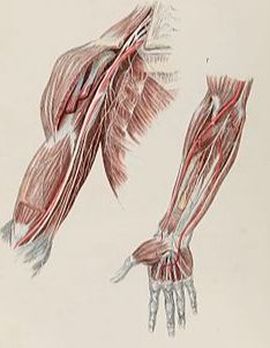TENDINOSIS OR FASCIAL ADHESIONS? |
(DOES IT REALLY MATTER?)
“The concept is that there is a loss of inflammatory response and chronic scar formation with fascia and tendon injuries. The proper terms for such injuries are fasciosis and tendinosis rather than the more commonly used terms of fasciitis and tendonitis. In fasciitis and tendonitis cases, there is good blood supply to the problematic region but there is an inflammatory response that is painful. In fasciosis and tendinosis issues, the fascia and ligament have a decrease in inflammatory response, a reduction in the growth/healing factors and a chronic scar formation that prevents the healing process.“
Dr. Babak Baravarian from the May 2009 issue of Podiatry TodayIf you have read my MAIN PAGE or BLOG POSTS on Tendinosis, you already realize that there are many experts saying that Tendinitis (the word ‘itis‘ means ‘Inflammation’) does not exist — or if it does exist — is extremely rare. What is common, however, is something called Tendinosis. But who really cares whether a person is dealing with an ‘osis‘ or an ‘itis‘? In other words, isn’t it just a word game — a matter of semantics that doesn’t really mean anything? No it’s not. Sit up and pay attention as I show you why.
According to an online Medical Dictionary, the suffix “osis” means, “a diseased or abnormal condition; an increase in a pathologic condition; production of an abnormal substance; increased production of a normal substance; a derangement of“. When it comes to Tendons or FASCIA (the membranous cover of muscles, organs, and other tissues), even though most of the problems found in these two tissues are believed to be more along the lines of an “osis,” they are usually treated as an “itis“. In other words, even though the peer-reviewed literature says otherwise, these problems are almost always diagnosed as Inflammatory conditions and subsequently treated as such — with ANTI-INFLAMMATION MEDS and CORTICOSTEROIDS. But is this the best option? Listen to a bit more of what Dr. Baravarian; a UCLA-affiliated foot doctor, has to say.
“It is ironic that we usually try to treat such issues on the acute (fasciitis/tendonitis) cases with rest while we try to treat the chronic issues (fasciosis/tendinosis) with cortisone injections. This does not make sense as an anti-inflammatory injection such as cortisone has a better chance of working in the acute phase when there is still an inflammatory process that is working. With chronic injuries such as Achilles tendinosis and plantar fasciosis, cortisone injections do not help very much. There is no inflammatory process with these injuries and the injection only works via the trauma caused by the needle, resulting in an inflammatory response in the designated area.”
Although Dr. Baravarian is speaking here about the foot, he could be talking about almost any part of the body. What is extremely intriguing is the fact that the Cortisone Injection itself is not only not beneficial, it’s actually harmful — extremely harmful as shown repeatedly in peer-review (HERE). The healing properties of the injection come about not from the medication, but from the INFLAMMATORY PROPERTIES OF THE NEEDLE that induces healing via the creation of an inflammatory response.
There are many different techniques that have the potential to create such an inflammatory response — a response that is both necessary and vital for healing to take place (remember, it’s too much inflammation that causes problems with the healing process). Acupuntcture is thought to do similar, as does the technique known as “Dry Needling” (see previous link). In this case, the physician takes a fairly heavy gauge needle and uses it to repeatedly puncture whatever area he is treating. Prolotherapy works by creating an inflammatory response with sugar water injections (HERE is a possible mechanism for creating such a response).
Our SCAR TISSUE REMODELING is designed to work in similar fashion (HERE are some pictures of the local inflammatory response). CHIROPRACTIC ADJUSTMENTS may even do this on a small scale as does STRETCHING & EXERCISE. Among other things, these are all designed to create some degree of FIBROBLASTIC RESPONSE.You must understand a couple of things here. When I say that Tendinosis is not an “Inflammatory” problem (HERE), what I mean is that it is not creating its own Inflammatory response. I do, however, believe that in many cases, SYSTEMIC INFLAMMATION has the ability to create, cause, or worsen local “non-inflammatory” problems. Let’s put this in practical terms as far as helping suffering people is concerned. If we can create a LOCAL Inflammatory response, while inhibiting SYSTEMIC Inflammation, the odds of licking the sorts of problems commonly found in (LIGAMENTS, TENDONS, MUSCLE, and FASCIA) increases dramatically. Beyond our Tissue Remodeling Treatment, HERE are is a post that might be of benefit as well.
Oh, and as to the “does it really matter?” quote from the top of the page; it doesn’t. The problem will be dealt with the same, whether it’s Fascial or Tendinous.


